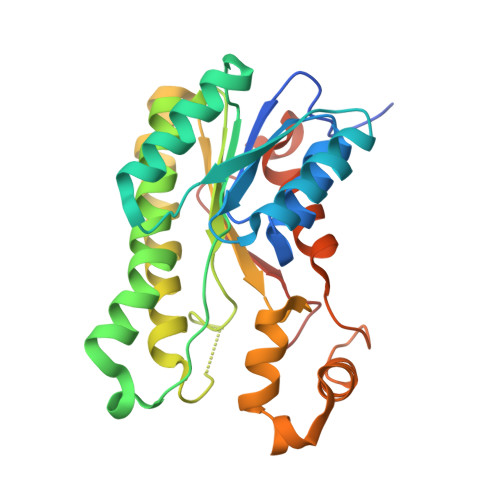Structural analysis of an anthrol reductase inspires enantioselective synthesis of enantiopure hydroxycycloketones and beta-halohydrins.
Hou, X., Xu, H., Yuan, Z., Deng, Z., Fu, K., Gao, Y., Liu, C., Zhang, Y., Rao, Y.(2023) Nat Commun 14: 353-353
- PubMed: 36681664
- DOI: https://doi.org/10.1038/s41467-023-36064-4
- Primary Citation of Related Structures:
7YB1, 7YB2, 8HFJ, 8HFK - PubMed Abstract:
Asymmetric reduction of prochiral ketones, particularly, reductive desymmetrization of 2,2-disubstituted prochiral 1,3-cyclodiketones to produce enantiopure chiral alcohols is challenging. Herein, an anthrol reductase CbAR with the ability to accommodate diverse bulky substrates, like emodin, for asymmetric reduction is identified. We firstly solve crystal structures of CbAR and CbAR-Emodin complex. It reveals that Tyr210 is critical for emodin recognition and binding, as it forms a hydrogen-bond interaction with His162 and π-π stacking interactions with emodin. This ensures the correct orientation for the stereoselectivity. Then, through structure-guided engineering, variant CbAR-H162F can convert various 2,2-disubstituted 1,3-cyclodiketones and α-haloacetophenones to optically pure (2S, 3S)-ketols and (R)-β-halohydrins, respectively. More importantly, their stereoselectivity mechanisms are also well explained by the respective crystal structures of CbAR-H162F-substrate complex. Therefore, this study demonstrates that an in-depth understanding of catalytic mechanism is valuable for exploiting the promiscuity of anthrol reductases to prepare diverse enantiopure chiral alcohols.
Organizational Affiliation:
Key Laboratory of Carbohydrate Chemistry and Biotechnology, Ministry of Education, School of Biotechnology, Jiangnan University, Wuxi, 214122, P. R. China.
















